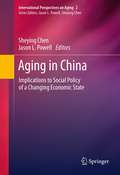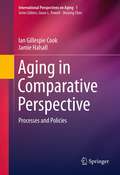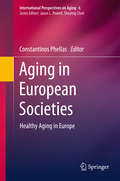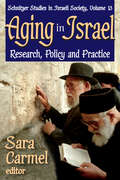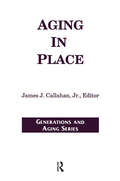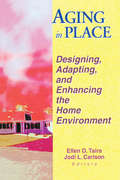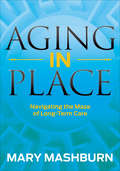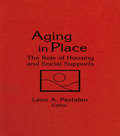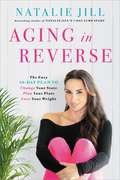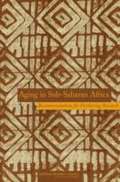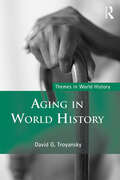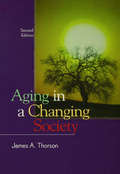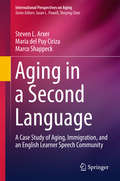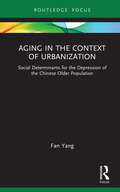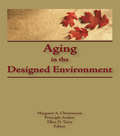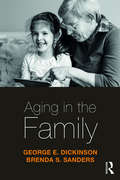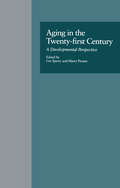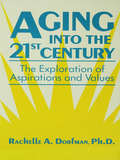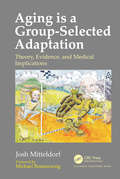- Table View
- List View
Aging in China: Implications to Social Policy of a Changing Economic State (International Perspectives on Aging #2)
by Jason L. Powell Sheying ChenChina, which is fast on its way to becoming the most powerful economic force in the world, has four unique characteristics that distinguish it from other countries in Asia: (1) The proportion of aging population is growing faster than that of Japan (the country previously recognized as having the fastest rate) and much faster than nations in western Europe. (2) An early arrival of an aging population before modernization has fully taken place, with social policy implications. It is certain that China will face a severely aged population before it has sufficient time and resources to establish an adequate social security and service system for older people. (3) There will be fluctuations in the total dependency ratio. The Chinese government estimates are that the country will reach a higher dependent burden earlier in the twenty-first century than was previously forecast. (4) The government's fertility policy (single child per family) and its implementation has a strong influence on the aging process. Fewer children are being born, but with more elderly people a conflict arises between the objectives to limit population increase and yet maintain a balanced age structure (Peng and Guo 2001). The intersection of these fourfold factors means that the increased aging population is giving rise to serious concerns among Chinese social policy makers. There is a chronic lack of good resource materials that attempt to make sense of social policy in its relationship to examining the problems and possibilities of human aging grounded in an analysis of economic of social policy in China and impact on rural and urban spaces. Such analysis of China will be covered by conceptual, theoretical, and empirical approaches. The book will also discuss substantive topics of housing, community care, family care, pensions, and mental health. The book brings together a truly world class array of researchers to provide discussions of critical implications of aging social policy and the economic impact in China.
Aging in Comparative Perspective: Processes and Policies (International Perspectives on Aging #1)
by Jamie Halsall Ian Gillespie CookThis book examines the key aging processes in seven countries (United States, United Kingdom, Sweden, Japan, China, Nepal, and South Africa) and the main policies that have been, and are being, developed to deal with this rapid change in the demographic profile. It addresses the problems that are identified as well as the positive aspects of aging within each of these contrasting societies. Thus it makes a significant contribution to the major debates about growing old across the globe.
Aging in European Societies: Healthy Aging in Europe (International Perspectives on Aging #6)
by Constantinos PhellasBetween longer life expectancies and declining birth rates, Europe's elder population is growing into a sizable minority with considerable impact on nations, health systems, and economies--in other words, global implications as well as local and regional ones. Those investing in the health of older adults need a double perspective: the social and clinical complexity of aging and the larger forces shaping these experiences. Aging in European Societies examines aging trends across the continent, analyzing individual and collective variables that affect the lives of older adults, and drawing salient comparisons with other parts of the world. An interdisciplinary panel of experts provides theory, research, and empirical findings (with examples from the UK, Cyprus, Sweden, and others) in key areas such as family and social supports, physical and cognitive changes, dependence and autonomy issues, and living arrangements. The book's wide-net approach offers insights into not only aging, but aging well. And of particular importance, it details approaches to defining and measuring the elusive but crucial concept, quality of life. Included in the coverage: The potential for technology to improve elders' quality of life.Dementia and quality of life issues.Changes in functional ability with aging and over time.Family networks and supports in older age.Factors influencing inequalities in quality of life.Late-life learning in the E.U. Gerontologists, sociologists, health and cross-cultural psychologists, and public health policymakers will welcome Aging in European Societies as a springboard toward continued discussion, new directions for research, and improvements in policy and practice.
Aging in Hong Kong: A Comparative Perspective (International Perspectives on Aging #5)
by Jean WooWith the longest life expectancy for men and the second longest for women, Hong Kong typifies our planet's aging population. The daily lives of its older adults closely match the advantages and disadvantages experienced by urban elders in other developed countries. For these reasons, Hong Kong's elderly serve as a salient guide to older people's social, psychological, and healthcare needs--concerns of increasing importance as the world grows older. Aging in Hong Kong examines this emblematic population as a case study specifically in comparison with their counterparts in the West, shedding light on diverse, interrelated currents in the aging experience. Referencing numerous international studies, the book contrasts different health service arrangements and social factors and relates them to a variety of health outcomes. Its wide-ranging coverage documents health and illness trends, reviews age-friendly policy initiatives, relates health literacy to patients' active role in their own care, and discusses elders as an underserved group in the division of limited health funding and resources. This multiple focus draws readers' attention to policies that need revisiting or retooling as chapters analyze major life areas including: Living environment.Retirement and post-retirement employment issues.Financial asset management.Health literacy regarding aging issues.Elder-positive service delivery models.Ageism in the prioritization of healthcare.End-of-life issues. By assembling such a wealth of data on its subject, Aging in Hong Kong puts ongoing challenges into clear focus for gerontologists, sociologists, health and cross-cultural psychologists, public health policymakers, and others involved in improving the quality of elders' lives.
Aging in Israel: Research, Policy and Practice
by Sara CarmelIn the twentieth century, all developed nations began to undergo unprecedented demographic changes, as their birth rates declined, and life expectancies increased significantly --an average of thirty years in less than a century. These developments have caused major transformations in the composition of populations in these countries, especially in terms of the proportions of the various age groups. While the age groups of children and adolescents have decreased, those of elderly persons aged 65 and over, have increased.Consistent with the situation in other developed nations, the absolute number and percentage of elderly persons in the Israeli population is increasing, while the percentage of younger persons is decreasing. Israel, however, differs from other developed countries in the pace of this demographic change, the composition of its population, and the ways it can address needs related to aging. The demographic figures in Israel indicate that not only is the proportion of elderly persons in the total population growing, but that the old population itself is rapidly aging as well.This volume exemplifies how social science research can promote knowledge about and understanding of needs and opportunities for adaptation, and assist in evaluating the outcomes of policies and services on the personal, community and national levels, as well as suggest required changes. The variety of topics covered in this volume on age-related research, policies and practice reflects a wide range of research by Israeli scholars on social aspects of aging. Their research offers a glimpse into the knowledge base that has been built over the years on the aging process in Israel, the population of elderly people, and the national policies and network of services for the aged. Other developed countries with aging populations have much to learn from the Israeli experience.
Aging in Place (Generations And Aging Ser.)
by James J. Callahan"Aging in place" is among the newer terms to be included along with "senior citizen," "golden agers," and others in the lexicon of gerontology. Since aging is a lifelong process and each of us occupies three-dimensional space, we are, of course, always aging in place, but two factors have caused aging in place to emerge as a salient concern for gerontological policy makers. The first is the explosive growth of homeownership after World War II, the other is the perception that thousands of older people have been flowing into nursing homes unnecessarily when they can and should remain in their own home or apartment.
Aging in Place with Dementia: Proceedings of a Workshop
by Committee on Population Division of Behavioral and Social Sciences and Education Board on Behavioral, Cognitive, and Sensory Sciences National Academies of Sciences, Engineering, and MedicineAlthough much research has been conducted on community-level factors related to the risk of dementia in general, less is known about the factors that affect the ability of older adults with dementia to age in place successfully. Additional research could lead to a better understanding of the data and resources needed to support innovative approaches for adaptive housing, services, and supports so that people living with dementia can remain in their communities. To explore these needs and develop effective strategies for the future, the Committee on Population and Board on Behavioral, Cognitive, and Sensory Sciences of the National Academies of Sciences, Engineering, and Medicine convened a virtual workshop on aging in place with dementia on September 13-15, 2023. Sponsored by the National Institute on Aging, this workshop highlighted the state of knowledge and identified research gaps to inform conceptual approaches to guide research on dementia-friendly communities in the U.S. context, building on existing approaches in the field.
Aging in Place: Designing, Adapting, and Enhancing the Home Environment
by Jodi Carlson Ellen D TairaProvide a comfortable living environment for the aging!Aging in Place: Designing, Adapting, and Enhancing the Home Environment gives you a complete examination of current trends in adaptive home designs for older adults. As a therapist, designer, architect, builder, home planner, social worker, community organizer, or gerontologist, Aging in Place will show you innovative home designs and studies for creating environments that offer optimal living for aging adults. Complete with diagrams, floor plans, and tables, Aging in Place helps you to improve the quality of life for the elderly by offering them state-of-the-art designs that encourage independence and dignity. This unique and exciting book covers topics such as universal design which strives to create everyday environments and products like door handles and light switches that are usable by all people to the greatest extent possible, regardless of age or ability. Aging in Place will also show you how to: use follow-up visits by occupational therapists to ensure successful use of home modifications create environments that are helpful for vision rehabilitation by using controlled lighting and color schemes evaluate the quality of life for elderly people living in personal dwellings, specialized housing, and nursing homes explore architectural barriers and the uses of helping devices for elderly people examine research critiques of adaptive toilet equipment investigate modifications that have been made in homes for the elderly in India analyze ways in which elderly people have changed their homes to make the telephone more accessibleAging in Place is a complete guide to understanding the needs and latest trends in optimizing the living space of elderly persons. The book gives you access to several studies on elderly people's environmental needs and preferences in regard to modifications in personal and public dwellings. This information will assist you with better serving the elderly by helping them live more independently.
Aging in Place: Navigating the Maze of Long-Term Care
by Mary MashburnAn elder care expert offers essential information and advice on how to give your aging parent or loved one the best care possible in this stage of life. Caring for an aging parent or loved one can be overwhelming. From making sure their estate is in order and knowing their wishes are being honored, to more immediate concerns like where they will receive the best care after a hospital stay—there are many questions that are difficult to answer. In Aging in Place, certified senior advisor Mary Mashburn guides you through these and other common concerns so that you can address them with confidence and compassion. Using real life examples, Aging in Place promotes healthy family discourse on important elder care topics. Mary discusses the roadblocks and pitfalls you and your family might encounter, explains many useful planning techniques, and provides information on local and national resources. Whether in the midst of a crisis or just beginning to discuss options with loved ones, Aging in Place offers valuable insight and information on making choices that fit your unique situation.
Aging in Place: The Role of Housing and Social Supports
by Leon A PastalanIn this highly practical volume, the contributing authors explore some of the dimensions associated with aging in place. There are increasing numbers of older Americans who are faced with fundamental changes in their economic circumstances, health, and marital status which have an impact on their ability to age in place. Without the necessary supports many may have no other choice but to be prematurely or inappropriately placed in costly health care facilities or be forced to move into unfamiliar, less safe, less satisfactory housing environments. Aging in Place explores some of the dimensions associated with aging in place and informs readers about unmet needs and available living options for elderly persons. Experts discuss a number of crucial factors regarding the availability of social supports and the impact it has on the independence of the elderly, specifically their living arrangements. They address the issue of control and how access to social contact and real choices about services and facilities increases independence among the elderly; congregate housing as an alternative to nursing care for those elderly too frail for less supportive housing; discharge policies concerning frailty in senior living arrangements; and the lack of a full range of services in many alleged full service communities.
Aging in Reverse: The Easy 10-Day Plan to Change Your State, Plan Your Plate, Love Your Weight
by Natalie JillHave you been feeling way too stressed out, pushing yourself too hard, thinking about all the things you can't do, and just not taking care of yourself?Licensed Master Sports Nutritionist, fat loss expert, and high performance coach Natalie Jill has helped hundreds of thousands of people around the world get in shape and be their best selves. Now, her new program will help you turn back the clock, turn setbacks into positives, and feel and look better than you ever have before. While many women over 40 hide their age, Natalie now flaunts hers: nearing 50, she's at the top of her game. The secret? Natalie's Transformation Triangle -- Change Your State, Plan Your Plate, and Love Your Weight. When you change your mindset and engage all three points of the Triangle, everything shifts. You feel better in your skin and you get stronger, your focus improves, and your motivation kicks in so you keep improving every day. Natalie gives you the tools to clear your brain, keep hot flashes in check, recharge, and get your mojo back -- that's what aging in reverse is all about.
Aging in Sub-Saharan Africa: Recommendation for Furthering Research
by National Research Council of the National AcademiesIn sub-Saharan Africa, older people make up a relatively small fraction of the total population and are supported primarily by family and other kinship networks. They have traditionally been viewed as repositories of information and wisdom, and are critical pillars of the community but as the HIV/AIDS pandemic destroys family systems, the elderly increasingly have to deal with the loss of their own support while absorbing the additional responsibilities of caring for their orphaned grandchildren. Aging in Sub-Saharan Africa explores ways to promote U.S. research interests and to augment the sub-Saharan governments' capacity to address the many challenges posed by population aging. Five major themes are explored in the book such as the need for a basic definition of "older person," the need for national governments to invest more in basic research and the coordination of data collection across countries, and the need for improved dialogue between local researchers and policy makers. This book makes three major recommendations: 1) the development of a research agenda 2) enhancing research opportunity and implementation and 3) the translation of research findings.
Aging in Twentieth-Century Britain (Berkeley Series in British Studies #12)
by Charlotte GreenhalghAs today’s baby boomers reach retirement and old age, this timely study looks back at the first generation who aged in the British welfare state. Using innovative research methods, Charlotte Greenhalgh sheds light on the experiences of elderly people in twentieth-century Britain. She adds further insights from the interviews and photographs of celebrated social scientists such as Peter Townsend, whose work helped transform care of the aged. A comprehensive and sensitive examination of the creative pursuits, family relations, work lives, health, and living conditions of the elderly, Aging in Twentieth-Century Britain charts the determined efforts of aging Britons to shape public understandings of old age in the modern era.
Aging in World History (Themes in World History)
by David G. TroyanskyIn Aging in World History, David G. Troyansky presents the first global history of aging. At a time when demographic aging has become a source of worldwide concern, and more people are reaching an advanced age than ever before, the history of old age helps us understand how we arrived at the treatment of aging in the modern world. This concise volume expands that history beyond the West to show how attitudes toward aging, the experiences of the aged, and relevant demographic patterns have varied and coalesced over time and across the world. From the ancient world to the present, this book introduces students and general readers to the history of aging on two levels: the experience of individual men and women, and the transformation of populations. With its attention to cultural traditions, medicalization, decades of historical scholarship, and current gerontology, Aging in World History is the perfect starting point for an exploration of this increasingly universal aspect of human experience.
Aging in a Changing Society
by James ThorsonThe field of gerontology, the study of aging, has emerged as an area of increasing importance. This book is an introduction to the multidisciplinary field of gerontology. The text, with its friendly narrative style, assumes no prior knowledge of gerontology, sociology, or psychology.
Aging in a Changing World: Older New Zealanders and Contemporary Multiculturalism (Global Perspectives on Aging)
by Molly GeorgeThis is a story about aging in place in a world of global movement. Around the world, many older people have stayed still but have been profoundly impacted by the movement of others. Without migrating themselves, many older people now live in a far “different country” than the one of their memories. Recently, the Brexit vote and the 2016 election of Trump have re-enforced prevalent stereotypes of “the racist older person”. This book challenges simplified images of the old as racist, nostalgic and resistant to change by taking a deeper, more nuanced look at older people’s complex relationship with the diversity and multiculturalism that has grown and developed around them. Aging in a Changing World takes a look at how some older people in New Zealand have been responding to and interacting with the new multiculturalism they now encounter in their daily lives. Through their unhurried, micro, daily interactions with immigrants, they quietly emerge as agents of the very social change they are assumed to oppose.
Aging in a Second Language: A Case Study of Aging, Immigration, and an English Learner Speech Community (International Perspectives on Aging #17)
by Steven L. Arxer Maria del Puy Ciriza Marco ShappeckThis unique account of English language acquisition by Latino elders shines intimate light on the increasingly complex concerns of aging immigrant minority populations. Rich qualitative findings detail sociocultural barriers to and social and emotive factors that promote second language acquisition in older age. The book's case study highlights diverse cognitive and social processes as elders establish a sense of self as learners and as part of a learning community, and a sense of place as newcomers navigating a challenging environment. And first-person comments from the group members deftly illustrate the intricacies of being an immigrant in a rapidly changing America as well as the myriad intersections of race/ethnicity, gender, culture, and country that shape immigrant life. Included in the coverage: Minority aging in an immigrant context. Late-life second language acquisition: cognitive and psycholinguistic changes, challenges, and opportunities. Building emotions for self-identity and learning. Practicing safe language socialization in private and public spaces. Language resocialization and gender allies. Aging, second language acquisition, and health. Aging in a Second Language gives clinical social workers, gerontologists, health and cross-cultural psychologists, sociologists, educators and other professionals deep insights into the lives of an emerging active elder population. It also pinpoints challenges and opportunities in research, literacy program design, pedagogy, clinical outreach, education policy, and service delivery to immigrant elders.
Aging in the Asian "Tigers": Challenges for Fiscal Policy 1
by Peter S. HellerFinancial report from the IMF
Aging in the Context of Urbanization: Social Determinants for the Depression of the Chinese Older Population (China Perspectives)
by Fan YangAs China has undergone rapid urbanization and population aging in the past few decades, improving the welfare of older people in rural areas has become an ever more pressing issue. This title is the first book-length work to examine the influence of urbanization on the mental health of China’s older population outside the city. Incorporating the theoretical framework of social ecology, the author analyzes the socio-cultural factors that have exerted an impact on participants’ mental health, such as their personal life course transition, changes to family living arrangements and community restructuring. Moreover, he introduces several elderly mental health intervention models in China, while evaluating the policy initiatives that have developed based on China’s local resource sufficiency, cultural customs, and older people's needs. The research findings not only facilitate a deeper understanding of China's welfare policy making, but also offers a useful reference for countries that are experiencing similar urbanization and population aging and that wish to formulate better social policies. Students and scholars of social policy, welfare, and gerontology will find this title to be essential reading.
Aging in the Designed Environment
by Ellen D Taira Margaret ChristensonAging in the Designed Environment is the key sourcebook for physical and occupational therapists developing and implementing environmental designs for the aging. The physical environment remains one of the most overlooked areas in environmental design. In order to move beyond this status quo, persons responsible for planning elderly environments must develop a new understanding of ways in which their influence can improve the older adult’s physical and mental functioning. Occupational and physical therapists, as well as other health care professionals, will benefit tremendously from the information presented in this unique volume. Designers, developers, and others with minimal health care background will also find a wealth of possibilities within Aging in the Designed Environment. Many concerns are dealt with in the book’s five sections. The first section describes the implications that occur when there are changes in vision, hearing, taste, smell, touch, and the kinesthetic systems. Recommendations for environmental adaptation and modifications which may compensate for the changes in each of these systems are suggested. The second section stresses the relationship between behavior and environment. A variety of environmental attributes--comfort, privacy, accessibility, control, security, dignity--and their impacts are discussed, along with information on ways that attributes can be incorporated into the living settings of older people. In section three the focus is on the older person living independently in his or her own home, and section four covers exclusively the design and selection of chairs for older adults. New ways to assess and evaluate the home to promote independence beyond the traditional activities of daily living are addressed. The last section deals with redesigning the existing long-term care facility. The author examines some of the environmental conditions existing in specific facilities and provides recommendations to compensate for these circumstances.
Aging in the Family
by George E. Dickinson Brenda S. SandersWith a rapidly aging population throughout the world, the issue of larger percentages of older adults has repercussions for both policy and the job market. Whether a university student about to seek a full-time job or a caregiver for an older person, Aging in the Family should enhance the reader’s knowledge and skills. The main topics covered in this volume include marital status of older adults, support systems within families, crises with older adults within families, the resilience of older adults entering the latter stages of life, practical information involving caregiving, aging in place, and various social services for an aging population. The reader will be made aware of intergenerational interactions between older adults and other family members in various cultures. The role of ethnicity and socio-economic status in health issues of older adults will be discussed, as will the application of technology to an aging population. Though problems certainly exist as one ages, the overall thrust of the book is toward the positive aspects of growing old. Numerous theories exist to probe research and understanding of older adults in families. The relation between theory and research will be helpful to many students of aging in the family. Older adults are generally married, yet cohabitation and other options are alive and well too. Ageism, death, and abuse, unfortunately, are issues affecting aging. Yet, most older adults in the US and Western Europe report living independently and being satisfied with their lives. Aging in the Family will be an interesting read for anyone wanting to learn about older adults and family relationships, as it exhibits a blend of both theoretical and practical matters.
Aging in the Twenty-first Century: A Developmental Perspective (Issues in Aging)
by Len Sperry Harry ProsenCovering a wide range of topics, this collection of original essays deals with the consequences and challenges of our growing aging population on society. It emphasizes aging as a developmental process while addressing the future of the practice of geropsychiatry and geriatric psychotherapy. This book serves as a valuable resource to guide clinical training, practice, and research on aging into the next century and beyond.
Aging into the 21st Century: The Exploration of Aspirations and Values
by Rachelle A. DorfmanAging Into the 21st Century draws on developmental theory and gerontological research to provide a framework for the creation of 'value-friendly' long-term care settings and for psychotherapy with the elderly.
Aging is a Group-Selected Adaptation: Theory, Evidence, and Medical Implications
by Joshua MitteldorfAlthough books exist on the evolution of aging, this is the first book written from the perspective of again as an adaptive program. It offers an insight into the implications of research on aging genetics, The author proposes the Demographic Theory of Senescence, whereby aging has been affirmatively selected because it levels the death rate over time helping stabilize population dynamics and prevent extinctions.
Aging of U.S. Air Force Aircraft: Final Report
by Committee on Aging of U.S. Air Force AircraftMany of the aircraft that form the backbone of the U.S. Air Force operational fleet are 25 years old or older. A few of these will be replaced with new aircraft, but many are expected to remain in service an additional 25 years or more. This book provides a strategy to address the technical needs and priorities associated with the Air Force's aging airframe structures. It includes a detailed summary of the structural status of the aging force, identification of key technical issues, recommendations for near-term engineering and management actions, and prioritized near-term and long-term research recommendations.
